The San Jose Sharks added a great deal of talent in the 2020 NHL Draft. The draft pick they got from the Tampa Bay Lightning ended up being 31st overall, but they knew it would be a late first when they traded Barclay Goodrow. Despite not having the highest draft picks, they arguably added four top forward prospects. In fact, for the first time in their history, the Sharks did not draft a defender or a goalie. Despite the lack of high picks, there is still reason for some optimism as there are some prospects that have a pretty bright future in this pyramid.
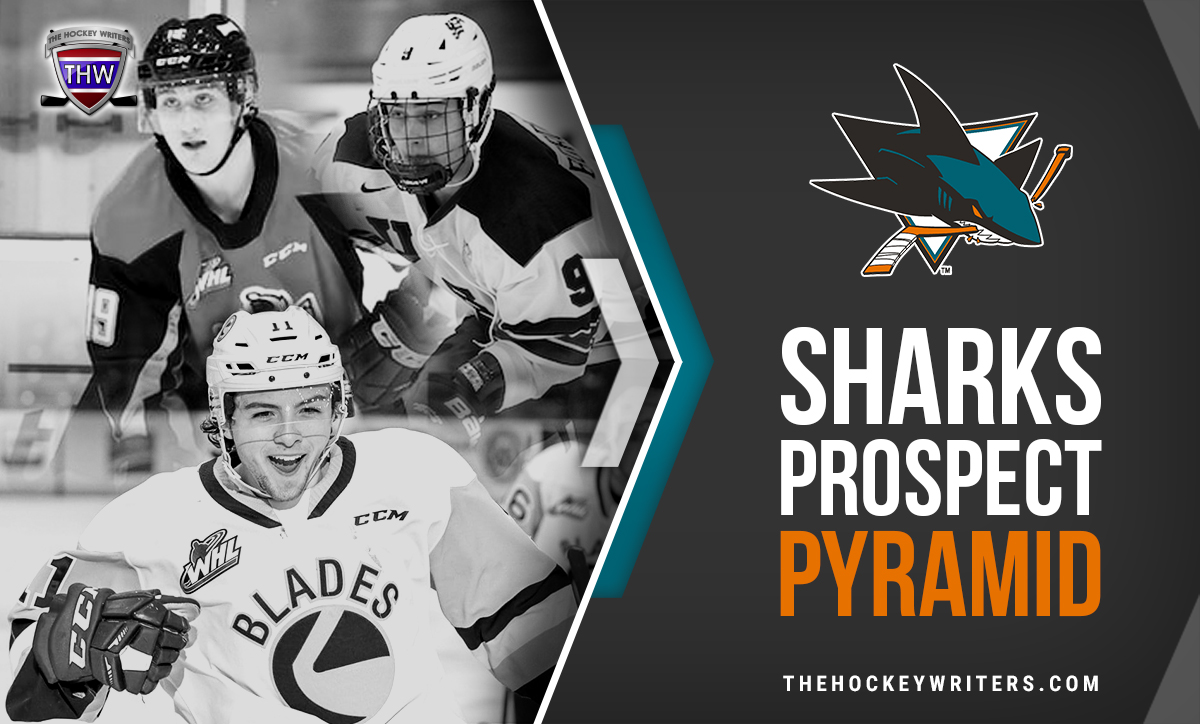
What is a Prospect Pyramid?
Sportsnet correspondent Steve “Dangle” Glynn first created the idea of a prospect pyramid for the Toronto Maple Leafs and has since become the new standard of sorting prospects in an organization. Dangle says that rather than trying to sort prospects in a numbered list, ranking them into tiers makes more sense than trying to decide who’s 15th and who’s 16th. The tiers look at their potential and group them accordingly rather than ranking them subjectively.
To explain the six tiers, here’s a written out breakdown, courtesy of THW’s own Brandon Share-Cohen:
Tier 1 – Elite talent (Rasmus Dahlin, Auston Matthews, Connor McDavid-level talent)
Tier 2 – Very, very good prospects with a real chance of being top-six forwards, top-two defenders or good starting goalies
Tier 3 – Good players who fall just short of Tier 2, perhaps due to lower ceilings, but who are distinctly better than tier’s below them
Tier 4 – Distinct shot at making an NHL roster and being a contributor (top-nine forward, bottom-four defender, fringe starter or backup goaltenders)
Tier 5 – Players who likely don’t project to be anything more than a role player in the NHL as their ceiling – these players’ chances of making the NHL aren’t very high compared to their comrades (sometimes due to being relatively unknown at this point)
Tier 6 – Players who have an uphill battle to make the NHL, or there isn’t enough information to make an informed decision
Also, there’s always talk about who classifies as a prospect. The Athletic’s Corey Pronman uses a good definition in his work, which I will apply here:
“A skater no longer qualifies as an NHL prospect if he has played 25 games in the NHL in any campaign, regular season and playoffs combined, or 50 games total; or reaches age 27 by Sept. 15.
“A goalie no longer qualifies as an NHL prospect if he has played 10 games in the NHL in any campaign, regular season and playoffs combined, or 25 games total; or reaches age 27 by Sept. 15.” (From: “Pronman: 2019-20 NHL Farm System Rankings”)
Additions, Subtractions, and Graduates
This is an update to the inaugural Sharks Prospect Pyramid originally published in September of 2020. Since then, there have been some minor subtractions and additions, but most notably, the 2020 draftees have been added. Even though the Sharks have one of the lower-ranked prospect pools, they remain a destination where players want to sign, especially those from Europe and Russia. There are two main reasons — for one the San Francisco Bay Area is an attractive area of the world in which to reside and for the other, the salary cap troubles of the Sharks means they have to give opportunities to players who are willing to sign for entry-level deals.
Additions
Trades: None
Free Agents: None
Draft: Ozzy Wiesblatt, Thomas Bordeleau, Tristen Robins, Daniil Gushchin, Brandon Coe, Alex Young, Adam Raska, Linus Oberg, Timofei Spitserov
Subtractions
Trades: None
Free Agency: Jeremy Roy, Andrew Shortridge, Anthony Greco
Graduates
Played more than 25 games: Mario Ferraro, Noah Gregor, Joel Kellman
Played more than 50 games, overall: None
Tier 1: Empty
Most teams don’t have a top-tier prospect and considering the Sharks have not selected higher than ninth overall (Timo Meier) in the last 10 years, it shouldn’t be a surprise. Most players in this tier are drafted first overall, something the Sharks have never done. The only player the team had in his prime that might have qualified for this tier is Joe Thornton, whom they acquired in a trade with the Boston Bruins. This is an incredibly hard tier to join and the way the Sharks seem to like to trade away their first-round picks, I’m not sure they will ever have a prospect in it.
Tier 2: Merkley, Wiesblatt, Bordeleau, Robins, Blichfeld, Chmelevski, Leonard, Kniazev, & Melnichuk
Even though the Sharks have no one in Tier 1, this tier is full of potential. Everyone here could be a top-end contributor to the Sharks in relatively short order, even their recent draft picks. What is especially exciting is that there are forwards, defensemen, and one goalie in this tier. That kind of balance is what you need to continue to field a playoff contender year after year. Especially since none of these players other than Merkley and Wiesblatt were first-round picks. Let’s dig into the outlook of Ryan Merkley, Ozzy Wiesblatt, Thomas Bordeleau, Tristen Robins, Joachim Blichfeld, Sasha Chmelevski, John Leonard, Artemi Kniazev, and Alexei Melnichuk.
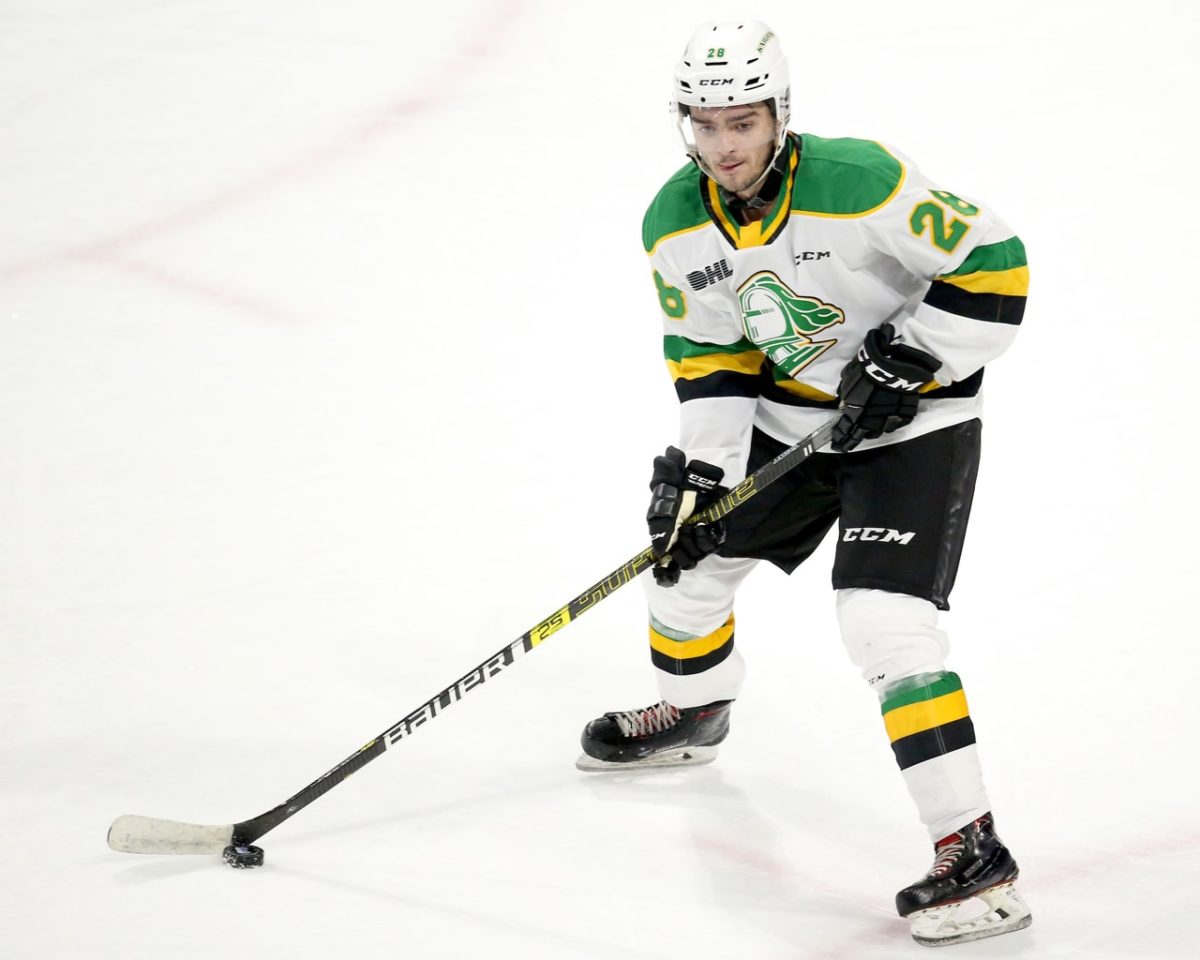
Merkley is considered by many to be the lone true gem of a prospect in the Sharks’ system. Though he clearly has a bit of a checkered past and murky future, there is no denying he is an elite talent. Drafted 21st overall in 2018 by the Sharks, the right-handed shot rearguard will be behind Brent Burns and Erik Karlsson on the depth chart, but will also get to learn from two Norris Trophy winners. Kevin Kurz of The Athletic has speculated that Burns might either get moved in a trade or be exposed to the Seattle expansion draft. (from “A 9-step plan for making the Sharks a playoff team again next season,” The Athletic 05/07/2020)
Either way, Merkley will have to prove he can excel at professional hockey in the AHL before he can prove himself in the NHL. One thing is for certain, the Sharks will be extra patient and give him every opportunity. He has elite offensive potential, but the defensive aspect of his game might never be better than average. He has seemed to put past transgressions behind him as the move to the London Knights of the Ontario Hockey League (OHL) has proved he can focus on hockey without being a distraction to the team.

According to Hockey Prospecting, Merkley had equal to Quinn Hughes in terms of star potential in their draft season. That number has faded since, but still sits at sixth best amongst a crop of budding NHL stars like Rasmus Dahlin, Andrei Svechnikov, Brady Tkachuk, and Evan Bouchard. This type of hype and projected star power will give Merkley about the longest leash you can imagine to be an impactful NHL regular.
Wiesblatt was the Sharks’ first-round pick in 2020 at 31st overall. Although he is a bit of a safe pick, in that his floor is very high, he has a pretty high ceiling, too. He made my pre-draft list of the top right wingers available in the 2020 Draft at number eight. The fact that he was the fourth right wing taken suggests it might have been a bit of a reach, but the Sharks get a very translatable player to the NHL. According to hockey prospecting, he has a 45% chance of making the NHL, a very high number for a player just drafted.
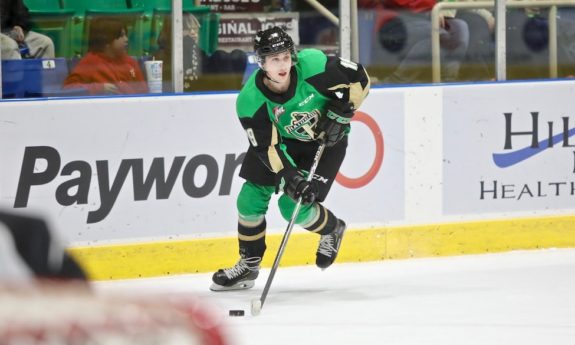
According to Mitchell Brown of Elite Prospects, Wiesblatt “is a human cheat code in transition” (Elite Prospects 2020 Draft Guide). What Brown means is that he is already elite both at gaining the offensive blue line and exiting his own zone with control. Looking at manual tracking data by Brown, only Jean-Luc Foudy is arguably better in transition than Wiesblatt.
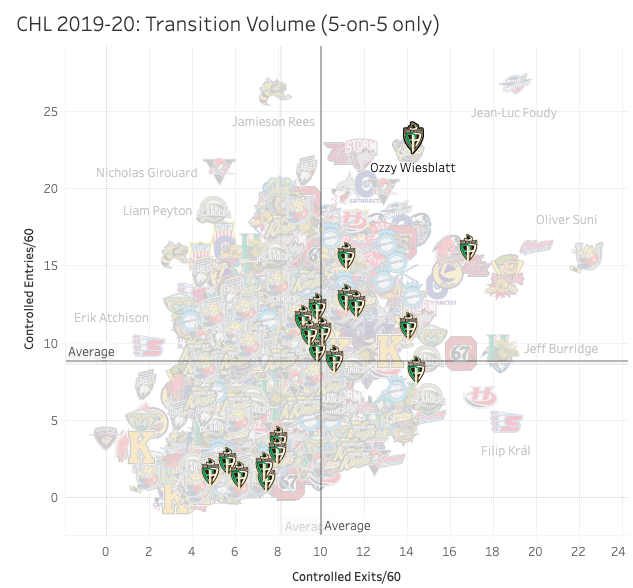
His skating is already NHL ready, which is a big leg up on many other prospects. It is quick, powerful, and he can blow by Western Hockey League (WHL) competition. While he won’t necessarily be able to do that at the NHL level, he will certainly be able to keep pace with his feet. There are a few areas where Wiesblatt needs to improve, but none that will prohibit him from making it to the NHL.
Wiesblatt’s shot is not great and even though he may fool some WHL goalies, it won’t beat professionals. He shoots a lot from low percentage areas and they don’t look particularly dangerous. When he does get in tight, he can finish, but needs to do a much better job of getting to those high-danger areas of the ice.
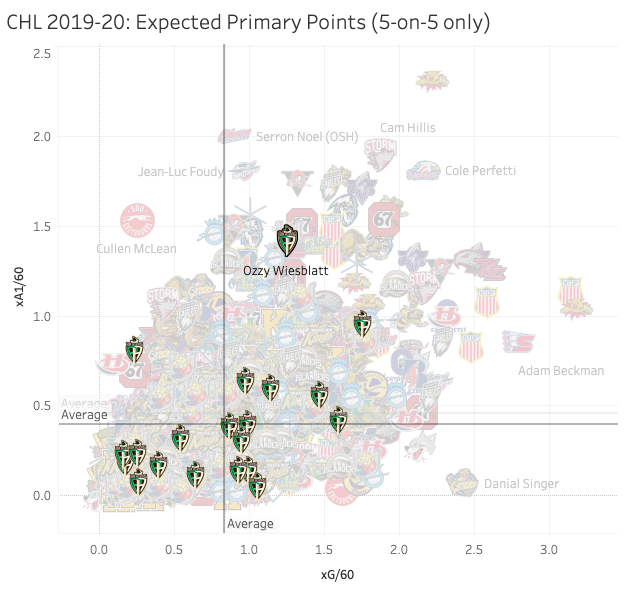
It seems pretty clear Wiesblatt can be at least an energy line player in the NHL, but there are questions as to his offensive upside. According to the expected primary assists and expected goals per 60 minutes by Brown, Wiesblatt seems to be one of the best playmakers in the Canadian Hockey League (CHL). He is in the same expected primary points part range as Dawson Mercer, Tyson Foerster, and Jake Neighbors, all of whom were taken in the first round of the 2020 Draft. While his goal production may be slightly underwhelming, he is a good dual threat to score or set up his teammates.
Bordeleau was taken 38th overall by the Sharks and was one of the top Americans available in the 2020 Draft. Though his size at 5-foot-9 is a major knock against him, he has some exciting attributes. First of all, he is excellent in the face-off circle. He is adept at turning his stick over and winning either from the left or right face-off dot. It is truly impressive to watch and that is something that, even if he slides to the wing as a professional, will still come in handy. He won 66% of offensive zone draws, 60% in the neutral zone, and 51% of defensive draws in 2019-20.
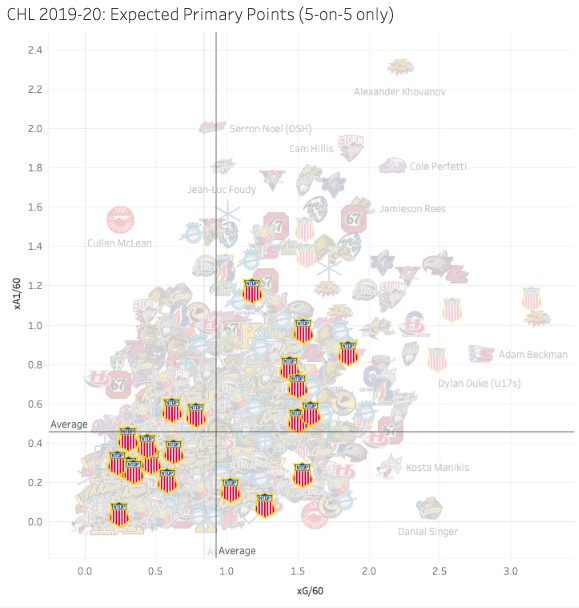
Despite his size, Bordeleau is adept at protecting the puck and finding teammates in prime scoring positions. His expected primary assist rate (xA1/60) is a testament to this. He is in the same expected primary points range as Wiesblatt, Mercer, Foerster, and Neighbors. He shoots from all over the ice and scores from various areas as well, even beyond the face-off dots.
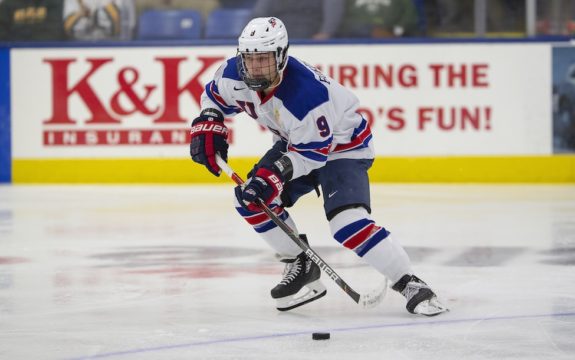
Bordeleau will play the 2020-21 season at the University of Michigan who are loaded with talent up front, including Erik Portillo, John Beecher, and Brendan Brisson. Hopefully, he gets plenty of power play time, but regardless it should be excellent for his development as the University of Michigan has a good track record of producing NHLers. The time in between games that the college schedule affords should allow him to spend much needed time in the weight room.
Robins was taken 56th overall by the Sharks and is instantly one of their best prospects. What he brings to the table is goal scoring, as he ranks in the 91st percentile in expected goals per 60 in the CHL and NCAA according to Mitchell Brown’s tracking data. In terms of offensive upside, Robins probably has the highest realistic upside of any Sharks forward.
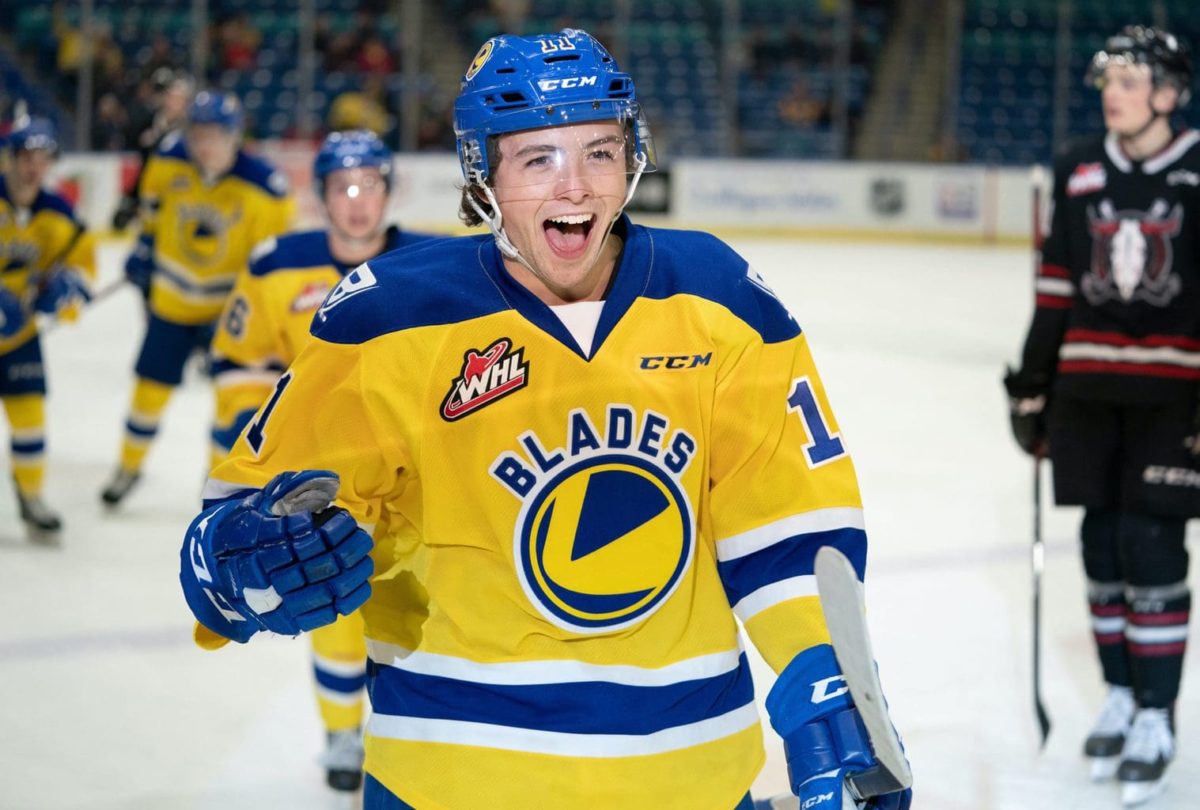
Robins scored at the same rate in his draft year as 2019 third-overall pick and former Saskatoon Blades teammate Kirby Dach. After Dach made the Chicago Blackhawks in 2019, it took Robins some time to become the go-to scorer for the Blades. He only had 21 points in his first 31 games, but then had 52 in the final 31. Seth Jarvis’ 61 in 31 was the only 2020 draft-eligible player with a more impressive final 31 games.
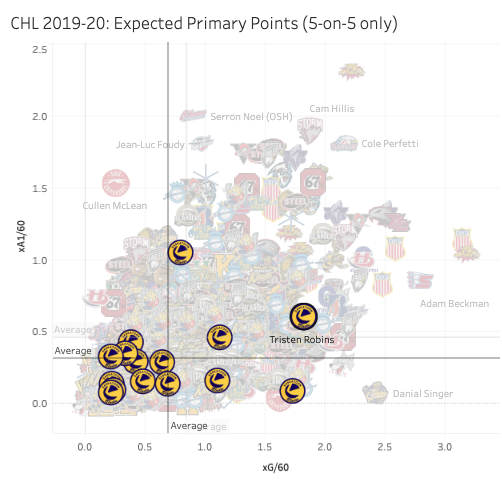
His shot is good and he lets it go from all over the ice, but his preferred shooting spot is the right face-off dot. He is able to create deception with his shot, bringing it into his feet as he releases, making it much harder for the goalie to see and save. His ability to make plays also makes him a more effective scorer. Even though he only ranks in the 78th percentile for primary assists per 60 in the CHL, that is still pretty high and it keeps the defense honest.
There aren’t too many holes in Robins’ game. He is a pretty good skater, good stick-handler, and decent defensively. He’ll never be the zone entry and exit machine that Wiesblatt is, but he can certainly improve there. It is also interesting that Wiesblatt and Robins are rivals in the WHL. Should they both return to their junior teams for the 2020-21 season, their rivalry will have added interest as hopeful future teammates.
Aside from the 2020 draftees, Blichfeld has shot up the depth chart of the prospect pyramid faster than anyone. The 2016 seventh-round pick (210th overall) just completed his first year of professional hockey in the AHL posting 32 points in 44 games and earning a selection as an All-Star. He was one of the lone bright spots for a Barracuda team that struggled. The large-framed Dane broke out in his third year of the WHL for the Portland Winterhawks, improving his point-per-game (P/G) pace in 2017-18 to much closer to two P/G (1.68) in 2018-19.
Blichfeld is blazing fast and his mind can process the game nearly as quickly. In his three-game stint with the Sharks this season, he did not look out of place. Obviously a three-game sample size is incredibly small, but per Evolving Hockey, Blichfeld generated 3.13 turnovers per 60 minutes, which would place him in the top 20 of the league in 2019-20. Being able to play either wing should help him make an impact with the Sharks earlier than later.
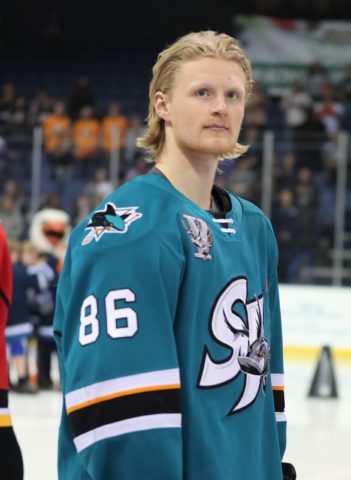
Blichfeld certainly has the tools to be a top-six player, but might settle in as a third-line energy player, too. His game reminds me of Nikolaj Ehlers, and not just because they are both Danish. As he awaits the start of the NHL and AHL seasons, he is playing in the top Danish league Metal Ligaen for Frederikshavn White Hawks. He’s getting close to 20 minutes of ice time per game, along with plenty of power-play time, which should all be good for his development.
Chmelevski’s development is a path you might imagine most prospects would take — slow and steady. While he has never been an elite scorer at the junior level, he made steady progress in the OHL over four seasons. His last season playing for the Ottawa 67’s he was pretty great, scoring 75 points in 56 games and 31 points in 18 playoff games as the team fell just short of an OHL championship. The 2019-20 season was his first full year with the Barracuda and he was good for 27 points in 42 games.
Chmelevski’s biggest weakness is his skating, which has steadily improved, even though he will never be considered fast. His best asset is his mind — he is able to position himself well and make efficient movements with his skating and usually negates the need for quick, agile movement of which he’s not so capable. In my prospect profile of him I compare him to Anthony Cirelli of the Tampa Bay Lightning and the Sharks would be elated if he could become a player of similar ilk. I doubt he will ever be a big scorer in the NHL, but he does project to be a top-six forward — probably a center — and that is something the Sharks need in a hurry, perhaps rushing his development a bit.
The Sharks may have hit on a true gem in the later part of the 2018 Draft taking Leonard in the sixth round (182nd overall), something they’ve made a habit of under Doug Wilson. He has a unique skill set in that he is a goal scorer, purer than anyone else in the system. Named as a finalist for the Hobey Baker Award as the top player in Collegiate Hockey, Leonard amassed an impressive 27 goals and 37 points in just 33 games for UMass (Amherst).
Thank you to everyone who voted on our John Leonard Top Goals of 2019-2020 Bracket and for @HobeyBakerAward 🙌
— UMass Hockey (@UMassHockey) March 31, 2020
Here’s your choice for @jleno09‘s best goal of the season 👇#BringHobeyH9me #NewMass | #Flagship 🚩 pic.twitter.com/OYXbXbNx4V
This was after a 40 point in 40 game sophomore campaign for the native of Amherst, Massachusetts. He signed his two-year, entry-level contract with the Sharks on March 31, 2020. He will begin his professional career with the Sharks in 2020-21 and depending on how that goes, he may get an earlier opportunity since the team is starving for cheap secondary scoring. I think Leonard’s skills will translate well to professional hockey; he surely has the competitive fire to continue to improve if it doesn’t.
Kniazev (sometimes spelled Knyazev) is a recent draft pick, 2019 second round (48th overall). The Russian left-handed defenseman, who is slightly undersized at 5-foot-11, did everything he could to justify that early selection by the Sharks this year by improving his point totals for Chicoutimi Sagueneens of the Quebec Major Junior Hockey League (QMJHL) from 34 points in 55 games in 2018-19 to 43 points in 51 games in 2019-20. Kniazev excelled at the 2020 summer U20 tournament in Sochi and was named the top defenseman amongst his peers.
He is an excellent skater and can create offense from the back end. The depth chart on the left side is pretty open for the Sharks currently being held by underachieving Marc-Edouard Vlasic, Radim Simek, and Mario Ferraro. Ferraro certainly has long-term upside, but Kniazev might be battling him for top-pairing minutes in a couple of years. This next season in the AHL will be an important one for his development.
Melnichuk is the newest player in the organization to find himself in this tier. He is a 22-year-old undrafted Russian player who has been developing in the SKA St. Petersburg system that has produced young phenom Igor Shestyorkin (sometimes spelled Shesterkin) and 2020 first-rounder Yaroslav Askarov. He only has 16 games of KHL experience, but after going 8-5-1 with 1.68 goals against average (GAA) and a .930 save percentage (SV%) the Sharks were the lucky winners of the Melnichuk sweepstakes.
Alexei Melnichuk of the San Jose Sharks! #WeAreGoldStar! pic.twitter.com/bnE91QzioV
— Gold Star Hockey (@GoldStarHockey) July 9, 2020
Despite being so young, he has the upside of being a star NHL starter. Of course, he has a lot to prove, especially since he has yet to play a minute of hockey on North American soil. He is so good technically, especially down low, yet he can be very athletic when needed. Despite his youth, I have him at the top of the Sharks pyramid for goalies. With the delayed start of the AHL and NHL, Melnichuk has been loaned to Torpedo Nizhny Novgorod of the KHL. He’s getting decent playing time and looking pretty good so far.
Tier 3: Dahlen, Gushchin, Coe, Spiridonov, Pasichnuk, Korenar, & Emond
Like the tier above, Tier 3 has players with a fair amount of potential. If it weren’t for some unfortunate circumstances or slight regression this past season, they could have very easily been in the tier above. I wouldn’t be surprised at all if one or more of these players surpassed one or two of the players in Tier 2. The Tier 3 players are Jonathan Dahlen, Daniil Gushchin, Brandon Coe, Yegor Spiridonov, Brinson Pasichnuk, Josef Korenar, and Zachary Emond.
Dahlen is the son of former Shark Ulf Dahlen, who had a very successful NHL career. The younger Dahlen has had a bit of a rollercoaster of development after being drafted 42nd overall by the Ottawa Senators in 2016. The Senators traded him to the Vancouver Canucks for Alexandre Burrows. After a couple of years frustrated that he wasn’t being called up and playing pretty well for the Utica Comets of the AHL, Dahlen was traded to the Sharks for Linus Karlsson, a player with a higher floor, but lower ceiling.
I get that Dahlen was having a disappointing year and hands were forced, but… Yikes.
— CanucksArmy (@CanucksArmy) February 25, 2019
– jd2 pic.twitter.com/rT1mtG8JBX
While the Sharks own the rights to Dahlen, he is committed to playing in the second tier of the Swedish hockey system the HockeyAllsvenskan, and Timra IK for 2020-21. Dahlen played for Timra during his early development and it seems he is regaining his poise and confidence after a rough stretch with the Comets. While there is still plenty of upside in his game, there are just as many questions, such as will he return to North America? Will he accept a role in the middle six? Will he re-sign with the Sharks after his commitment to Timra? We shall see. Early viewings show him tearing up the HockeyAllsvenskan.
In the third round of the 2020 Draft, the Sharks selected Gushchin at 78th overall who is another highly skilled, yet severely undersized forward. At only 5-foot-8, Gushchin doesn’t play small. He breaks many stereotypes of Russian forwards in that he isn’t afraid to battle for pucks. He also dished out a hit at least every other game in the United States Hockey League (USHL). His puck handling is amongst the best in the 2020 Draft.
Gushchin gets a lot of velocity on his shots, even if only 57% of them hit the target. He is tenacious defensively, always battling for the puck — the type of two-way feistiness that will endear him to any coach. According to hockey prospecting, he has an 11% chance of becoming a star producer and a 45% chance of becoming an NHLer. That is good value in the third round. He was expected to refine his skills in the OHL for the Niagara IceDogs after being drafted fourth overall in the CHL Import Draft, but they have loaned him back to the Muskegon Lumberjacks of the USHL.
Coe was selected in the fourth round of the 2020 Draft (98th overall). Like Wiesblatt, Coe makes an appearance on the list of top right wingers available in the 2020 Draft at number nine. Unlike some of the smaller players taken by the Sharks in the 2020 Draft, he is a large man and plays physical, too. He averaged almost a hit per game for the North Bay Battalion of the OHL in 2019-20. He is a good skater, especially for his size. He is great at getting the puck in the offensive zone and exiting his own zone with control. Even though his offensive upside seems modest at best, he is an adept two-way forward averaging almost three takeaways per game for a defensively poor Battalion team.
Spiridonov was drafted by the Sharks in 2019, fourth round (108th overall). He split the 2019-20 season in Russia between the MHL (analogous to junior) and the VHL (analogous to the AHL). The Sharks saw him slipping in the draft as many outlets saw him as a second rounder — they gave the Montreal Canadiens their 2020 fourth-round pick in order to snag him. He is a strong two-way player that excels at puck possession. He has several aspects of his game to work on like his skating and his shot. According to Hockey Prospecting, Spiridonov looks analogous to former Colorado Avalanche star Milan Hejduk. He will have to continue to show he can produce at both the VHL and KHL level before Sharks fans can start to get too excited, but that is obviously a very exciting comparison.
After serving as Captain for the Arizona State University Sun Devils for two seasons, the highly coveted undrafted 22-year-old Pasichnuk signed a two-year, entry-level deal with the Sharks. He finished his final collegiate season with 47 points in 36 games. He’s a good skater with above-average hockey IQ and hopes to follow the path of Torey Krug as an undrafted college star to make an impact in the NHL. No doubt the allure of playing alongside either Burns or Karlsson, as well as the relative paucity of talent on the left attracted him to sign with the Sharks instead of elsewhere. I doubt he has high points upside, but he has a fairly high floor to be a serviceable NHL defenseman.
The undrafted Korenar appeared prime to compete for an NHL roster spot in 2020-21 after an excellent 2018-19 campaign that saw him go 23-8-3 for the Barracuda along with a .911 SV% and 2.54 GAA. Unfortunately, he regressed in 2019-20 and his record fell to 12-16-7, .891 SV%, and 3.11 GAA. Perhaps returning to HC Ocelari Trinec of the Tipsport Extraliga in the Czech Republic will help him return to his form of two seasons ago. He is probably the goalie closest to being NHL ready that the Sharks have if the team doesn’t sign a veteran backup. Despite his readiness, I’m not sure his upside is all that high, perhaps a split starter or 1A at best.
The goalie with perhaps the greatest upside for the Sharks is also the one who is furthest from being NHL ready. Emond was taken in the sixth round in 2018 (176th overall) and the 6-foot-3, 20-year-old just finished his third full season in the QMJHL. After a rocky 2017-18 where he posted a .897 SV% with a 2.36 GAA for Rouyn-Noranda Huskies in 24 games, he had a dazzling 1.73 GAA with a .932 SV% in 2018-19. His numbers in 2019-20 were slightly worse as the team around him graduated several key players from the program.
Tier 4: Chekhovich, True, Letunov, Meloche & Hamaliuk
The Sharks currently have five players who could make the NHL roster but in more of a role-player position. These players include Ivan Chekhovich, Alexander True, Nicolas Meloche, Nick DeSimone and Dillon Hamaliuk.
Chekhovich was taken in the 2017 seventh round (212th overall), the same year the Sharks took Chmelevski. The fact that he’s even this high in the pyramid is a testament to the scouting, drafting, and development of the Sharks. It’s understandable why he slipped so far as he put up just under a point per game for the Baie-Comeau Drakkar of the QMJHL in his draft year. He followed that up with a disappointing 60 points in 65 games in his draft plus-one year, though his stellar nine points in six games for the Barracuda were eye popping. In 2018-19, his draft plus-two season, he popped 105 points in 66 games and another seven points in nine games for the Barracuda, including the playoffs.
We strongly suggest you CHEKK these highlights out 😁 pic.twitter.com/v34GUy2bgz
— San Jose Barracuda (@sjbarracuda) July 10, 2020
His transition as a full-time AHL player was a little rough as he only managed 12 points in 42 games. As an undersized player measuring 5-foot-10, he will need to work much harder against bigger and stronger competition. With the delay in the AHL season, Chekhovich has been loaned to Torpedo Nizhny Novgorod of the KHL. Unlike many player loans that are temporary, this one is for the entire season. Increasing his ice time from around 11 minutes for the Barracuda to over 18 minutes in the KHL should help him regain his confidence. I still have my reservations about him becoming a full-time NHL player.
Nikolaj Ehlers’ cousin True is an undrafted center who was never a big point producer in the WHL when the Sharks signed him in summer 2018. He was a bit of a disappointment in 2019-20 for the Barracuda after an impressive 2018-19 campaign that saw him garner 55 points in 68 points. The great Dane standing at 6-foot-5 and 200 pounds has the tools to become an NHL regular and his 12 games for the Sharks in 2019-20 enforces this assertion.
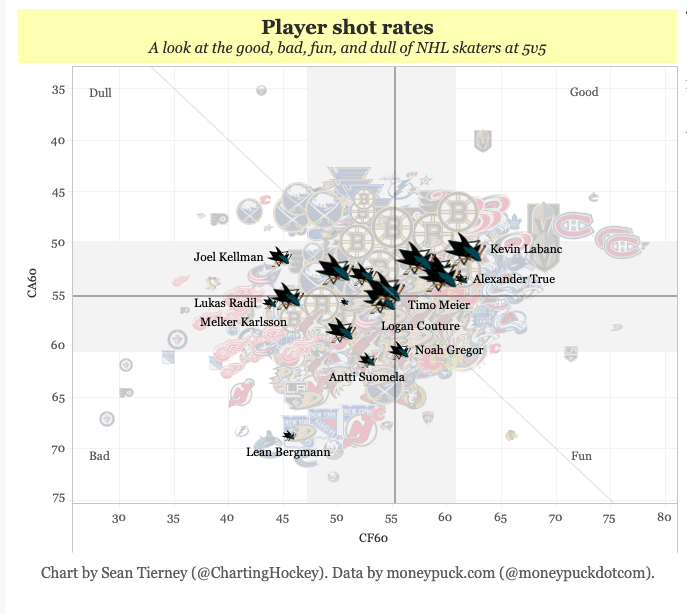
Though 12 NHL games is an extremely small sample size, True definitely held his own in player shot rates, a combination of Corsi for per 60 minutes and Corsi against per 60 minutes. Many other young players on this list did not fare so well, including Noah Gregor, Antti Suomela, and Lean Bergmann. This makes me think True would make a good third-line center, though second-line upside is still there.
Letunov is a 24-year-old Russian prospect that the Sharks coveted back in 2014, but was originally drafted by the St. Louis Blues 52nd overall. They eventually acquired him through the Arizona Coyotes from the Blues. After three seasons at the University of Connecticut, he finished with 95 points in 105 games, though his freshman season was his best leading to some disappointment as he endured the dreaded downward trend. His transition to the AHL was okay in 2018-19, but 2019-20 showed him lead the Barracuda with 40 points in 50 games. As a large-framed (6-foot-4), two-way center, Letunov could certainly make an impact for the Sharks as a middle-six pivot, but the points upside seems a bit limited.
Meloche was originally drafted in 2015 by the Colorado Avalanche in the second round (40th overall). The Sharks acquired him for Antoine Bibeau in September 2019. A puck-moving, right-handed defenseman, Meloche had high expectations when he was drafted, but has been trending downward, both in his final seasons in the QMJHL and recently in the AHL. There is still hope — about a 28% chance according to Hockey Prospecting — of him becoming an NHL player, but the upside seems to be bottom pairing at this point.
Dillon Hamaliuk is a 2019 second-round pick by the Sharks (55th overall). His draft year was shortened to 31 games by injury, but he still put up 26 points for the Seattle Thunderbirds of the WHL. In his draft plus-1 season, he played for the Kelowna Rockets of the WHL and saw a regression of only 31 points in 56 games. You never want to see regression like that from your prospects, but hopefully he can turn the tide and compete for a roster spot on the Barracuda in 2020-21. He still has a lot of upside as a left winger with a good combination of size and skill. The Sharks certainly hope he can become a power forward utilizing his strength to win battles in the corner and beat goalies with his above-average shot.
Tier 5: Halbgewachs, Viel, Yurtaikin, Middleton, Knyzhov, DeSimone, Kotkov, Carrick, & Ibragimov
Jayden Halbgewachs, Jeffrey Viel, Danil Yurtaikin, Jacob Middleton, Nikolai Knyzhov, Nick DeSmione, Trevor Carrick, and Timur Ibragimov fill out Tier 5, all players who could make the NHL, but at this point, it looks like a long-shot for them to become regulars with the Sharks.
Jayden Halbgewachs is an undersized (5-foot-8), undrafted left winger who the Sharks signed in December 2017. At that time, he was in the midst of his fourth and best season for the Moose Jaw Warriors of the WHL that concluded totaling 129 points in 64 games. The 23-year-old has now played two seasons for the Barracuda going from .55 to .64 points per game in those campaigns. He is currently a restricted free agent (RFA), so it remains to be seen what the Sharks will do with him; his size remains a key limitation to his NHL success. The Sharks certainly hope the player nicknamed the “magic man” can end up being more like Johnny Gaudreau or Marin St. Louis, though the time to pull this rabbit out of his hat is running out.
Viel (or Truchon-Viel) is a 23-year-old, undrafted winger that the Sharks signed after an impressive QMJHL career for the Acadie-Bathurst Titan. He was captain of the team his final two seasons and in his final year they won both the QMJHL title and the Memorial Cup. He also took home CHL Memorial Cup All-Star honors and QMJHL Playoffs MVP along the way. Though never a big point producer, topping out at 62 points in 59 games, he clearly has some intangible leadership and championship qualities that the Sharks covet. In two seasons with the Barracuda he has increased his P/G pace from .32 to .56. He was also assigned the assistant captain “A” in 2019-20, hinting that he has both the trust of the coaching staff and a voice they want to amplify. He definitely seems like he might be able to carve out a bottom-six role with the Sharks in the future.
Yurtaikin (or Yurtaykin) is a slightly undersized (5-foot-11) Russian player who was not drafted by any NHL team. After putting up 19 points in 40 KHL games as a 22-year-old, the Sharks signed him to a two-year, entry-level deal in April 2019. Surprisingly, and almost entirely due to the Sharks’ lack of forward depth, Yurtaikin made the team out of training camp. He did not look great in his four-game audition with the Sharks and was sent to the Barracuda where he posted 17 points in 37 games. A creative player with the ability to hold on to the puck and draw players to him, he will need to make quicker and better decisions if he wants to stick in the NHL.
Middleton was originally drafted by the Los Angeles Kings back in 2014 in the seventh round (210th overall). After three years with the Ottawa 67’s, the final one in which he was named captain, he was not offered a contract by the Kings so the Sharks signed him. He was never a big point producer, not even reaching .5 P/G in junior, but he was an assistant captain for the Barracuda for two seasons. This year he got a 10-game stint for the Sharks after their defensive core was depleted.

Those 10 games showed he can have a positive shot rate against NHL competition, which is why he is in Tier 5 and not Tier 6. Even if he does stick in the NHL, which I’m not at all confident he will, it will be in a depth role, perhaps even a seventh or eighth defenseman. Middleton is an RFA currently so the Sharks have to make a decision regarding what they plan to do with him.
Knyzhov, not to be confused with Artemi Knyazev, is a 22-year-old, left-handed, undrafted defenseman that the Sharks signed out of the SKA St. Petersburg system after rising through the ranks from the MHL to the VHL to the KHL in 2018-19. In 33 Barracuda games, he has scored just five points, deployed more in a shut-down role. He did earn a three-game call-up to the Sharks. I don’t see a high upside here, but the recent call-up saved him from falling to the sixth tier.
Nick DeSimone is an undrafted defenseman signed by the Sharks out of Union College of the NCAA. The 25-year-old put up 46 points in 65 games during his second season with the Barracuda during 2018-19, but took a bit of a step back in 2019-20. With good size and skill, the Sharks have him signed for one more season until they have to make a decision on his future with the organization.
Vladislav Kotkov is a 20-year-old Russian who was undrafted out of the CSKA Moskva system. The 6-foot-4 winger came to the QMJHL in his draft year and posted 49 points in 61 games for the Chicoutimi Sagueneens. After the draft, the Sharks signed him to a three-year, entry-level contract only to see his production dip in year two to 46 points in 51 games. He was recently traded to the Saint John Sea Dogs and this year will be really important for him to see if he can climb the pyramid out of Tier 5. He certainly has the physical tools to do so. Another disappointing year in the QMJHL might lead to a departure for Russia.
Carrick is a 26-year-old, left-handed defenseman who has played the majority of his career in the AHL. Hockey Prospecting has listed him as a “bust,” so I don’t expect much from him at this point. He is a classic quad “A” player who may just be too good for the AHL, but not quite good enough for the NHL. As an “older” prospect, he will likely be off this list one way or another in a year.
Ibragimov is a slightly undersized Russian prospect who the Sharks selected in the sixth round in 2019 (164th overall) from the SKA-St. Petersburg system. He is a creative offensive player that has work to do in his own zone. In his draft year, he seemed like a bit of a long-shot to make the NHL and in his draft plus-one year he took a bit of a step back, his NHLe going down from 19 to 15 as he transitioned from the MHL to the VHL. At 19, he has an uphill battle to climb to even make the KHL and from there he’d have to cross the Atlantic and prove himself again. A whole lot of questions and not a lot of answers.
Tier 6: Young, Raska, Oberg, Spitserov, Gallant, Weatherby, Reedy, Wiederer, McGrew, Sund, Robinson
Tier 6 is for those who either really won’t have a shot at the NHL or there isn’t enough information to make an informed decision. All the later-round 2020 draftees are going here just because there isn’t as much known about them and I didn’t think any were particularly great swings, but time will tell. The Sharks do have a history of late-round draft success, so I’m holding out hope at least one of these guys makes it to the NHL.
This includes Alex Young, Adam Raska, Linus Oberg, Timofei Spitserov, Zach Gallant, Jasper Weatherby, Scott Reedy, Manuel Wiederer, Jake McGrew, Tony Sund, and Mike Robinson.
The Prospect Pyramid is Constantly Changing
As prospects continue their career, they can rise and fall through the tiers on this list. Blichfeld is a prime example of this, as he may have been in Tier 3 or Tier 4 had it not been for his exceptional last year of junior in the WHL and his first professional season in the AHL. Many of these prospects could slide up or down the tiers depending on what happens next. The point is, these groupings are not a fixed evaluation of these prospects, but a fluid guide that is constantly changing as moves are made in the organization, drafts occur and the general progression or regression of their play.
All stats were provided by InStat